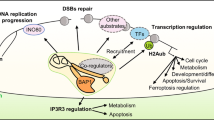Abstract
We have identified a novel protein, BAP1, which binds to the RING finger domain of the Breast/Ovarian Cancer Susceptibility Gene product, BRCA1. BAP1 is a nuclear-localized, ubiquitin carboxy-terminal hydrolase, suggesting that deubiquitinating enzymes may play a role in BRCA1 function. BAP1 binds to the wild-type BRCA1-RING finger, but not to germline mutants of the BRCA1-RING finger found in breast cancer kindreds. BAP1 and BRCA1 are temporally and spatially co-expressed during murine breast development and remodeling, and show overlapping patterns of subnuclear distribution. BAP1 resides on human chromosome 3p21.3; intragenic homozgyous rearrangements and deletions of BAP1 have been found in lung carcinoma cell lines. BAP1 enhances BRCA1-mediated inhibition of breast cancer cell growth and is the first nuclear-localized ubiquitin carboxy-terminal hydrolase to be identified. BAP1 may be a new tumor suppressor gene which functions in the BRCA1 growth control pathway.
Similar content being viewed by others
Author information
Authors and Affiliations
Rights and permissions
About this article
Cite this article
Jensen, D., Proctor, M., Marquis, S. et al. BAP1: a novel ubiquitin hydrolase which binds to the BRCA1 RING finger and enhances BRCA1-mediated cell growth suppression. Oncogene 16, 1097–1112 (1998). https://doi.org/10.1038/sj.onc.1201861
Received:
Revised:
Accepted:
Published:
Issue Date:
DOI: https://doi.org/10.1038/sj.onc.1201861
- Springer Nature Limited
Keywords
This article is cited by
-
The BAP1 nuclear deubiquitinase is involved in the nonhomologous end-joining pathway of double-strand DNA repair through interaction with DNA-PK
Oncogene (2024)
-
BAP1 as a guardian of genome stability: implications in human cancer
Experimental & Molecular Medicine (2023)
-
Deficiency of BAP1 inhibits neuroblastoma tumorigenesis through destabilization of MYCN
Cell Death & Disease (2023)
-
Targeting BAP1 with small compound inhibitor for colon cancer treatment
Scientific Reports (2023)
-
Loss of BAP1 Protein Expression by Immunohistochemistry in the Salivary Duct Carcinoma Component of an Intracapsular Carcinoma ex Pleomorphic Adenoma of the Parotid Gland
Head and Neck Pathology (2023)




